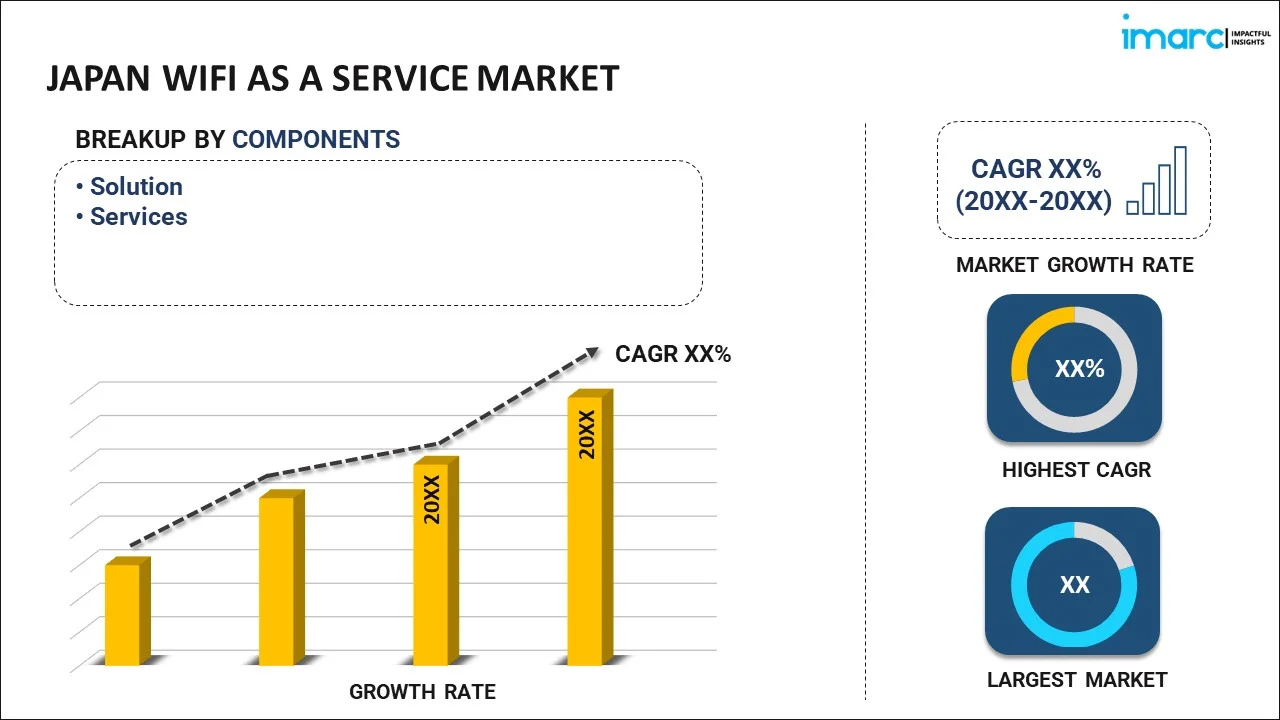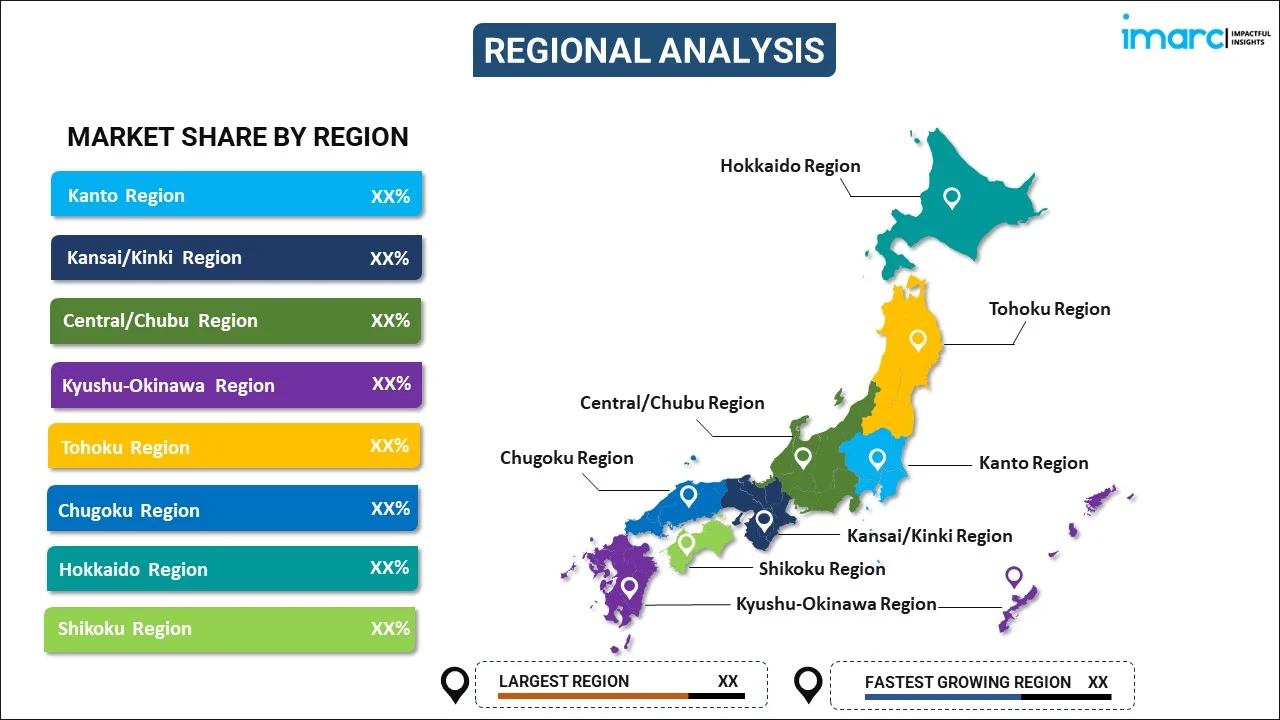
Japan WiFi as a Service Market Report by Component (Solution, Services), Location Type (Indoor, Outdoor), Enterprise Size (Large Enterprises, Small and Medium-sized Enterprises), End Use Industry (Telecom and IT, BFSI, Education, Healthcare, Hospitality, Transportation, Retail, and Others), and Region 2025-2033
Market Overview:
Japan WiFi as a service market size reached USD 331.5 Million in 2024. Looking forward, IMARC Group expects the market to reach USD 1,815.9 Million by 2033, exhibiting a growth rate (CAGR) of 19.1% during 2025-2033. The increasing demand for wireless connectivity and the inflating utilization of robust and reliable WiFi networks by both businesses and consumers, is primarily driving the market.
|
Report Attribute
|
Key Statistics
|
|---|---|
|
Base Year
|
2024 |
|
Forecast Years
|
2025-2033
|
|
Historical Years
|
2019-2024
|
| Market Size in 2024 | USD 331.5 Million |
| Market Forecast in 2033 | USD 1,815.9 Million |
| Market Growth Rate (2025-2033) | 19.1% |
WiFi as a service (WaaS) is a revolutionary approach to wireless networking that has transformed the way businesses and organizations manage their connectivity needs. Unlike traditional WiFi setups, where companies invest in expensive infrastructure and hardware, WaaS offers a subscription-based model that provides hassle-free, scalable, and cost-effective WiFi solutions. With WaaS, businesses can easily adapt to changing connectivity demands. Whether it's a small startup or a large enterprise, WaaS allows for flexibility and scalability, enabling organizations to expand or reduce their WiFi coverage as needed. This eliminates the need for significant upfront capital investments and reduces the burden of ongoing maintenance and upgrades. Furthermore, WaaS providers handle the technical aspects of network management, ensuring security, performance, and reliability. This frees up IT teams to focus on more strategic initiatives, enhancing overall productivity. WaaS is particularly beneficial for businesses in industries like hospitality, retail, healthcare, and education, where seamless and reliable WiFi connectivity is essential for customer satisfaction and operational efficiency.
Japan WiFi as a Service Market Trends:
The WiFi as a service market in Japan is experiencing remarkable growth due to several key drivers that are shaping its trajectory. Firstly, the increasing proliferation of mobile devices and the growing demand for high-speed internet connectivity have driven the need for scalable and reliable WiFi solutions. Consequently, this surge in mobile device usage has fueled the adoption of WiFi as a service, as it offers flexible and cost-effective solutions for businesses to meet their connectivity demands. Moreover, the ongoing trend of remote and hybrid work arrangements has further propelled the WiFi as a service market forward. Companies are recognizing the importance of providing seamless and secure WiFi access to their remote workforce, driving up the demand for cloud-managed WiFi services. Additionally, the rapid digital transformation across various industries, such as retail, healthcare, and hospitality, which has spurred the need for agile and easily deployable WiFi solutions, is expected to drive the WiFi as a service market in Japan during the forecast period.
Japan WiFi as a Service Market Segmentation:
IMARC Group provides an analysis of the key trends in each segment of the market, along with forecasts at the country level for 2025-2033. Our report has categorized the market based on component, location type, enterprise size, and end use industry.
Component Insights:

- Solution
- Access Points
- WLAN Controllers
- Others
- Services
The report has provided a detailed breakup and analysis of the market based on the component. This includes solution (access points, WLAN controllers, and others) and services.
Location Type Insights:
- Indoor
- Outdoor
A detailed breakup and analysis of the market based on the location type have also been provided in the report. This includes indoor and outdoor.
Enterprise Size Insights:
- Large Enterprises
- Small and Medium-sized Enterprises
The report has provided a detailed breakup and analysis of the market based on the enterprise size. This includes large enterprises and small and medium-sized enterprises.
End Use Industry Insights:
- Telecom and IT
- BFSI
- Education
- Healthcare
- Hospitality
- Transportation
- Retail
- Others
A detailed breakup and analysis of the market based on the end use industry have also been provided in the report. This includes telecom and IT, BFSI, education, healthcare, hospitality, transportation, retail, and others.
Regional Insights:

- Kanto Region
- Kansai/Kinki Region
- Central/ Chubu Region
- Kyushu-Okinawa Region
- Tohoku Region
- Chugoku Region
- Hokkaido Region
- Shikoku Region
The report has also provided a comprehensive analysis of all the major regional markets, which include Kanto Region, Kansai/Kinki Region, Central/ Chubu Region, Kyushu-Okinawa Region, Tohoku Region, Chugoku Region, Hokkaido Region, and Shikoku Region.
Competitive Landscape:
The market research report has also provided a comprehensive analysis of the competitive landscape. Competitive analysis such as market structure, key player positioning, top winning strategies, competitive dashboard, and company evaluation quadrant has been covered in the report. Also, detailed profiles of all major companies have been provided.
Japan WiFi as a Service Market Report Coverage:
| Report Features | Details |
|---|---|
| Base Year of the Analysis | 2024 |
| Historical Period | 2019-2024 |
| Forecast Period | 2025-2033 |
| Units | Million USD |
| Scope of the Report | Exploration of Historical and Forecast Trends, Industry Catalysts and Challenges, Segment-Wise Historical and Predictive Market Assessment:
|
| Components Covered |
|
| Location Types Covered | Indoor, Outdoor |
| Enterprise Sizes Covered | Large Enterprises, Small and Medium-sized Enterprises |
| End Use Industries Covered | Telecom and IT, BFSI, Education, Healthcare, Hospitality, Transportation, Retail, Others |
| Regions Covered | Kanto Region, Kansai/Kinki Region, Central/ Chubu Region, Kyushu-Okinawa Region, Tohoku Region, Chugoku Region, Hokkaido Region, Shikoku Region |
| Customization Scope | 10% Free Customization |
| Post-Sale Analyst Support | 10-12 Weeks |
| Delivery Format | PDF and Excel through Email (We can also provide the editable version of the report in PPT/Word format on special request) |
Key Questions Answered in This Report:
- How has the Japan WiFi as a service market performed so far and how will it perform in the coming years?
- What has been the impact of COVID-19 on the Japan WiFi as a service market?
- What is the breakup of the Japan WiFi as a service market on the basis of component?
- What is the breakup of the Japan WiFi as a service market on the basis of location type?
- What is the breakup of the Japan WiFi as a service market on the basis of enterprise size?
- What is the breakup of the Japan WiFi as a service market on the basis of end use industry?
- What are the various stages in the value chain of the Japan WiFi as a service market?
- What are the key driving factors and challenges in the Japan WiFi as a service?
- What is the structure of the Japan WiFi as a service market and who are the key players?
- What is the degree of competition in the Japan WiFi as a service market?
Key Benefits for Stakeholders:
- IMARC’s industry report offers a comprehensive quantitative analysis of various market segments, historical and current market trends, market forecasts, and dynamics of the Japan WiFi as a service market from 2019-2033.
- The research report provides the latest information on the market drivers, challenges, and opportunities in the Japan WiFi as a service market.
- Porter's five forces analysis assist stakeholders in assessing the impact of new entrants, competitive rivalry, supplier power, buyer power, and the threat of substitution. It helps stakeholders to analyze the level of competition within the Japan WiFi as a service industry and its attractiveness.
- Competitive landscape allows stakeholders to understand their competitive environment and provides an insight into the current positions of key players in the market.
Need more help?
- Speak to our experienced analysts for insights on the current market scenarios.
- Include additional segments and countries to customize the report as per your requirement.
- Gain an unparalleled competitive advantage in your domain by understanding how to utilize the report and positively impacting your operations and revenue.
- For further assistance, please connect with our analysts.
 Inquire Before Buying
Inquire Before Buying
 Speak to an Analyst
Speak to an Analyst
 Request Brochure
Request Brochure
 Request Customization
Request Customization




.webp)




.webp)












